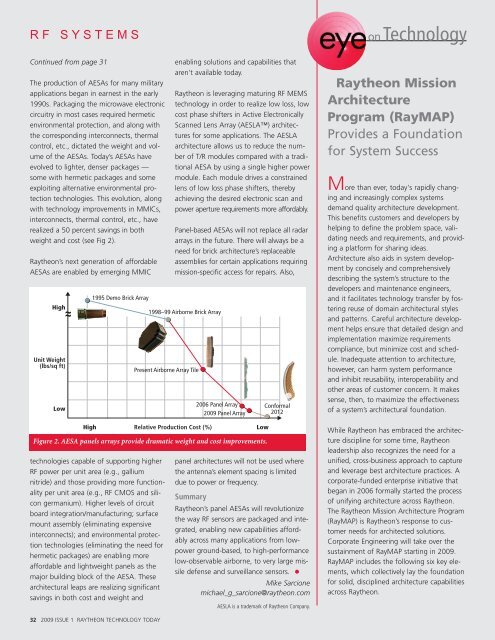2009 Issue 1 - Raytheon
2009 Issue 1 - Raytheon
2009 Issue 1 - Raytheon
You also want an ePaper? Increase the reach of your titles
YUMPU automatically turns print PDFs into web optimized ePapers that Google loves.
RF SYSTEMS<br />
Continued from page 31<br />
The production of AESAs for many military<br />
applications began in earnest in the early<br />
1990s. Packaging the microwave electronic<br />
circuitry in most cases required hermetic<br />
environmental protection, and along with<br />
the corresponding interconnects, thermal<br />
control, etc., dictated the weight and volume<br />
of the AESAs. Today’s AESAs have<br />
evolved to lighter, denser packages —<br />
some with hermetic packages and some<br />
exploiting alternative environmental protection<br />
technologies. This evolution, along<br />
with technology improvements in MMICs,<br />
interconnects, thermal control, etc., have<br />
realized a 50 percent savings in both<br />
weight and cost (see Fig 2).<br />
<strong>Raytheon</strong>’s next generation of affordable<br />
AESAs are enabled by emerging MMIC<br />
High<br />
Unit Weight<br />
(lbs/sq ft)<br />
Low<br />
1995 Demo Brick Array<br />
technologies capable of supporting higher<br />
RF power per unit area (e.g., gallium<br />
nitride) and those providing more functionality<br />
per unit area (e.g., RF CMOS and silicon<br />
germanium). Higher levels of circuit<br />
board integration/manufacturing; surface<br />
mount assembly (eliminating expensive<br />
interconnects); and environmental protection<br />
technologies (eliminating the need for<br />
hermetic packages) are enabling more<br />
affordable and lightweight panels as the<br />
major building block of the AESA. These<br />
architectural leaps are realizing significant<br />
savings in both cost and weight and<br />
32 <strong>2009</strong> ISSUE 1 RAYTHEON TECHNOLOGY TODAY<br />
enabling solutions and capabilities that<br />
aren’t available today.<br />
<strong>Raytheon</strong> is leveraging maturing RF MEMS<br />
technology in order to realize low loss, low<br />
cost phase shifters in Active Electronically<br />
Scanned Lens Array (AESLA) architectures<br />
for some applications. The AESLA<br />
architecture allows us to reduce the number<br />
of T/R modules compared with a traditional<br />
AESA by using a single higher power<br />
module. Each module drives a constrained<br />
lens of low loss phase shifters, thereby<br />
achieving the desired electronic scan and<br />
power aperture requirements more affordably.<br />
Panel-based AESAs will not replace all radar<br />
arrays in the future. There will always be a<br />
need for brick architecture’s replaceable<br />
assemblies for certain applications requiring<br />
mission-specific access for repairs. Also,<br />
1998–99 Airborne Brick Array<br />
Present Airborne Array Tile<br />
2006 Panel Array<br />
<strong>2009</strong> Panel Array<br />
High Relative Production Cost (%)<br />
Low<br />
Figure 2. AESA panels arrays provide dramatic weight and cost improvements.<br />
Conformal<br />
2012<br />
panel architectures will not be used where<br />
the antenna’s element spacing is limited<br />
due to power or frequency.<br />
Summary<br />
<strong>Raytheon</strong>’s panel AESAs will revolutionize<br />
the way RF sensors are packaged and integrated,<br />
enabling new capabilities affordably<br />
across many applications from lowpower<br />
ground-based, to high-performance<br />
low-observable airborne, to very large missile<br />
defense and surveillance sensors.<br />
Mike Sarcione<br />
michael_g_sarcione@raytheon.com<br />
AESLA is a trademark of <strong>Raytheon</strong> Company.<br />
onTechnology<br />
<strong>Raytheon</strong> Mission<br />
Architecture<br />
Program (RayMAP)<br />
Provides a Foundation<br />
for System Success<br />
More than ever, today's rapidly changing<br />
and increasingly complex systems<br />
demand quality architecture development.<br />
This benefits customers and developers by<br />
helping to define the problem space, validating<br />
needs and requirements, and providing<br />
a platform for sharing ideas.<br />
Architecture also aids in system development<br />
by concisely and comprehensively<br />
describing the system’s structure to the<br />
developers and maintenance engineers,<br />
and it facilitates technology transfer by fostering<br />
reuse of domain architectural styles<br />
and patterns. Careful architecture development<br />
helps ensure that detailed design and<br />
implementation maximize requirements<br />
compliance, but minimize cost and schedule.<br />
Inadequate attention to architecture,<br />
however, can harm system performance<br />
and inhibit reusability, interoperability and<br />
other areas of customer concern. It makes<br />
sense, then, to maximize the effectiveness<br />
of a system’s architectural foundation.<br />
While <strong>Raytheon</strong> has embraced the architecture<br />
discipline for some time, <strong>Raytheon</strong><br />
leadership also recognizes the need for a<br />
unified, cross-business approach to capture<br />
and leverage best architecture practices. A<br />
corporate-funded enterprise initiative that<br />
began in 2006 formally started the process<br />
of unifying architecture across <strong>Raytheon</strong>.<br />
The <strong>Raytheon</strong> Mission Architecture Program<br />
(RayMAP) is <strong>Raytheon</strong>’s response to customer<br />
needs for architected solutions.<br />
Corporate Engineering will take over the<br />
sustainment of RayMAP starting in <strong>2009</strong>.<br />
RayMAP includes the following six key elements,<br />
which collectively lay the foundation<br />
for solid, disciplined architecture capabilities<br />
across <strong>Raytheon</strong>.

















